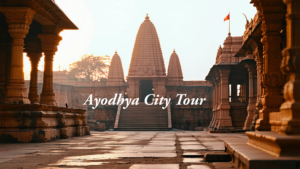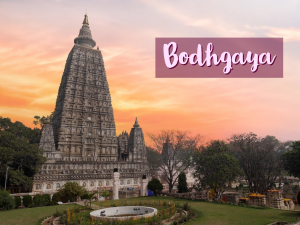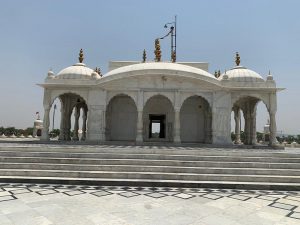Indian History Learning Online: A Smarter, More Fun Way to Discover India’s Past
India’s history isn’t just found in textbooks—it’s carved into ancient temples, buried beneath ruined cities, and told through sacred sites and monuments that still stand today. But you don’t need to travel across the country to explore them. With learning.travelbaits.in, you can experience the history of India’s most iconic places—right from your screen.
This isn’t just online learning. It’s a journey through time, where stories, architecture, and culture come alive through virtual tours, videos, and interactive content.
Learn the History Behind India’s Most Iconic Heritage Sites
1. Bodh Gaya – Where Enlightenment Began
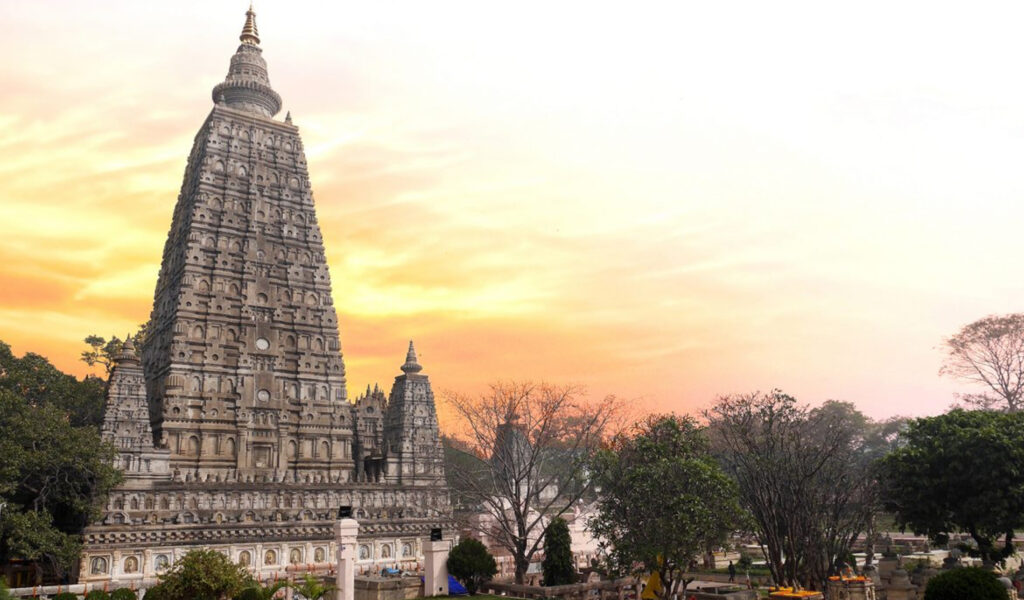
Nestled on the banks of the Niranjana River in Bihar, Bodh Gaya is one of the most spiritually significant places in the world. It is here, under the sacred Bodhi Tree, that Prince Siddhartha Gautama meditated deeply and attained enlightenment, becoming Gautama Buddha, the founder of Buddhism.
For over two thousand years, this small town has been visited by pilgrims and seekers from around the world. It has been turned into a global center of peace, reflection, and learning. Bodh Gaya is an essential part of Indian History Learningfor those who want to explore India’s spiritual past.
The Story of Buddha’s Enlightenment
At the age of 29, Prince Siddhartha left his royal comforts in search of truth and an end to human suffering. After years of spiritual practice and self-discipline, he arrived in Gaya and sat in meditation beneath a fig tree—later known as the Bodhi Tree. On the full moon night of Vaishakha, he attained nirvana, or complete awakening, realizing the Four Noble Truths and the Eightfold Path.
This profound moment didn’t just change Siddhartha’s life—it reshaped the spiritual landscape of Asia and the world.
The Mahabodhi Temple Complex
The centerpiece of Bodh Gaya is the Mahabodhi Temple, a stunning architectural site that marks the exact spot of the Buddha’s enlightenment. Originally built by Emperor Ashoka in the 3rd century BCE, the temple you see today dates back to the 5th–6th centuries CE and is one of the oldest surviving brick temples in India.
- The central spire, rising over 50 meters, symbolizes the path to enlightenment.
- The Vajrasana (Diamond Throne) beneath the Bodhi Tree is believed to be the precise spot where the Buddha sat.
- The Bodhi Tree itself, though a descendant of the original, remains a powerful symbol of wisdom and awakening.
The temple is a UNESCO World Heritage Site, not just for its architectural value but also for its deep spiritual meaning.
Buddhist Traditions Still Practiced Today
Bodh Gaya is more than a monument—it’s a living pilgrimage center. Every year, thousands of monks, nuns, and lay practitioners visit to meditate, chant, and pay homage.
- Monks from countries like Tibet, Sri Lanka, Thailand, Japan, and Myanmar perform rituals in their native styles.
- The Kagyu Monlam Chenmo, an annual prayer festival, brings together international Buddhist communities.
- The air is often filled with chants, incense, and peaceful silence, offering a truly meditative environment.
Visitors can also explore monasteries representing different countries, each showcasing unique Buddhist art, scriptures, and practices.
Learn About Bodh Gaya Online
Through learning.travelbaits.in, you can:
- Take a virtual tour of the Mahabodhi Temple Complex
- Watch the story of Buddha’s life unfold through visual storytelling
- Explore Buddhist teachings and cultural rituals
- Understand the global importance of Bodh Gaya as a spiritual capital
2. Hampi – The Forgotten Empire of Vijayanagara
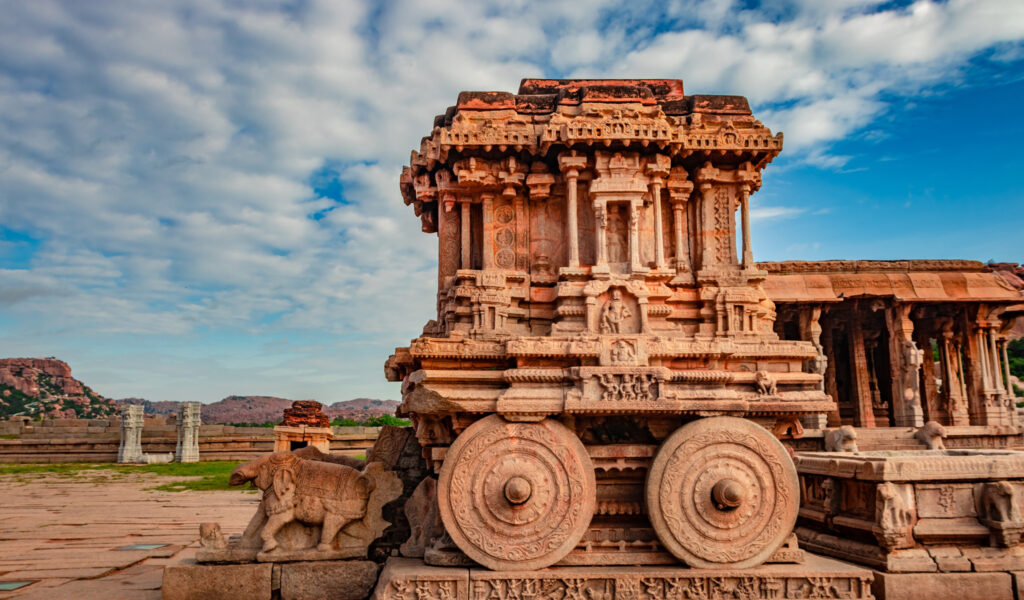
Set amidst a surreal landscape of massive boulders, flowing rivers, and ancient ruins, Hampi in Karnataka was once the thriving capital of the Vijayanagara Empire—one of the greatest South Indian kingdoms in history. In the 14th and 15th centuries, it was considered one of the richest and most advanced cities in the world, often compared by travelers to Rome for its wealth and grandeur.
Today, Hampi has been declared a UNESCO World Heritage Site. Its stone chariots, royal palaces, temples, and market streets are admired for telling silent stories of artistic excellence, cultural life, and historical greatness. Hampi is widely explored in Indian History Learning for its unmatched legacy.
The Rise and Fall of the Vijayanagara Empire
Founded in 1336 CE by Harihara and Bukka, the Vijayanagara Empire grew rapidly to become a dominant power in South India, both militarily and culturally. It served as a stronghold of Hindu resistance against invading forces and became a beacon of temple architecture, literature, trade, and urban planning.
- Under rulers like Krishnadevaraya, the empire reached its golden age. He was a great patron of art, Sanskrit, and Telugu literature, and oversaw the construction of many iconic structures in Hampi.
- The empire fell in 1565 CE after the Battle of Talikota, when a coalition of Deccan Sultanates defeated Vijayanagara forces and looted the city. Hampi, once bustling with life, was reduced to ruins in just a few days.
Yet, these ruins still speak loudly of a civilization that once rivaled the best in the world.
Temple Carvings, Market Streets & Ancient Engineering
Hampi is a treasure trove of Dravidian architecture, stone sculpture, and ingenious urban design.
- The Virupaksha Temple, dedicated to Lord Shiva, is one of the oldest functioning temples in India, with its massive gopuram (gateway tower) dominating the skyline.
- The Vittala Temple is famous for its stone chariot and musical pillars—each producing a distinct tone when tapped.
- Hampi Bazaar, a vast marketplace in front of the Virupaksha Temple, once bustled with merchants from Persia, Arabia, and Southeast Asia.
- Advanced water systems, including step wells, aqueducts, and bathing pavilions, reveal a deep understanding of hydraulics and urban planning.
Every corner of Hampi is a lesson in design, devotion, and daily life during a time when India’s kingdoms flourished with culture and innovation.
Daily Life in a 14th-Century South Indian Capital
Hampi wasn’t just a political capital—it was a cosmopolitan city, buzzing with activity.
- People from various cultures—traders, artisans, scholars, dancers, and pilgrims—lived side by side.
- Grand processions, music, dance festivals, and temple rituals were regular parts of public life.
- The city had separate quarters for soldiers, nobles, traders, and foreign guests, showing a well-organized social structure.
The art, food, religious practices, and architecture of Hampi all reflect a society that was deeply spiritual, highly advanced, and remarkably inclusive.
Explore Hampi Online with TravelBaits
At learning.travelbaits.in, you can:
- Take a virtual tour of Hampi’s majestic ruins
- Learn the stories of the Vijayanagara kings and queens
- See detailed visuals of temples, royal enclosures, and sacred rivers
- Understand how one of India’s greatest empires was built—and how it fell
3. Nalanda – India’s Ancient University Town
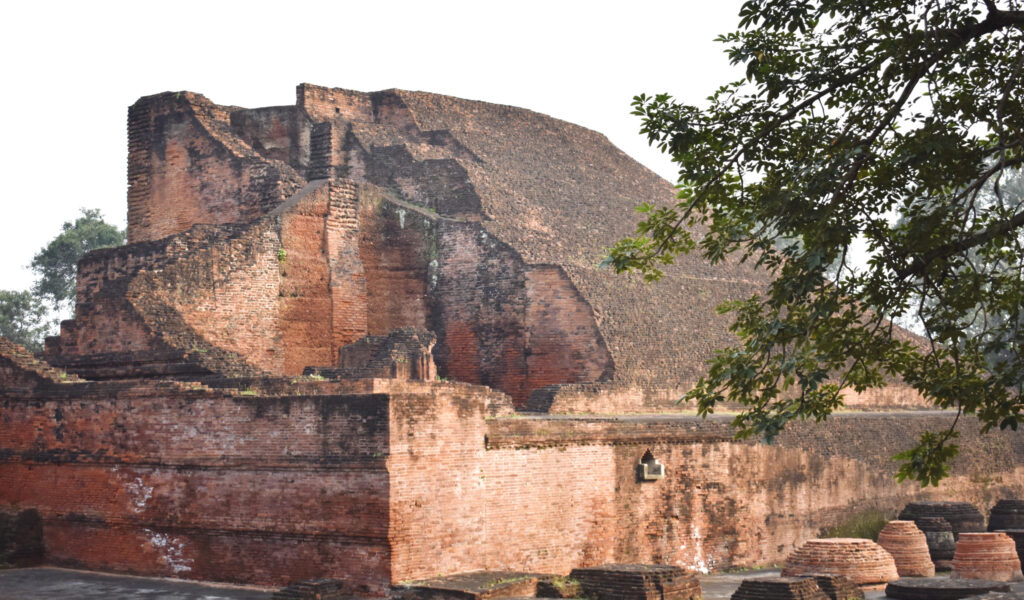
Long before the world had Oxford or Harvard, India had Nalanda—a world-class university and learning hub that drew scholars, monks, and students from across Asia. Located in present-day Bihar, Nalanda Mahavihara was more than just a university—it was a thriving intellectual ecosystem that shaped the development of education, philosophy, and Buddhism for centuries.
Today, the red-brick ruins of Nalanda are visited for the stories they tell of ancient wisdom and academic excellence from over 1,500 years ago. Declared a UNESCO World Heritage Site, it is often explored in Indian History Learning as a shining example of India’s rich educational heritage.
The Ancient Education System of India
Founded in the 5th century CE during the Gupta Empire, Nalanda became the first residential university in the world—with thousands of students and hundreds of teachers living and studying together in a large campus setting.
- Students had to pass tough entrance interviews—only the most curious and committed minds were admitted.
- Learning was free of cost, supported by royal patronage and donations.
- Nalanda wasn’t just about books—it was about debate, discussion, and immersive learning.
This system reflected India’s deep-rooted tradition of Gurukul learning, scaled up to an international level.
What Students Studied 1,500 Years Ago
Nalanda offered a wide range of subjects, both spiritual and secular. The curriculum was incredibly advanced for its time:
- Buddhist Philosophy & Logic – At the heart of Nalanda’s teachings, practiced through deep inquiry and debate.
- Grammar, Rhetoric & Sanskrit Literature – Language arts were key for mastering scriptures and communication.
- Mathematics & Astronomy – Students studied the movements of stars and the logic of numbers.
- Medicine (Ayurveda) – Healing traditions and diagnostics were taught through observation and practical training.
- Arts & Architecture – Creativity was nurtured as a part of holistic education.
The university had nine massive libraries, with manuscripts that attracted scholars from all over Asia.
A Global Center of Knowledge and Exchange
Nalanda wasn’t just a national treasure—it was a global beacon of learning. Scholars and monks from China, Korea, Tibet, Sri Lanka, and other parts of Asia came here to study and teach.
- The Chinese traveler Xuanzang (Hsuan-Tsang) spent over 10 years at Nalanda, documenting its vibrant academic life and taking Buddhist texts back to China.
- Tibetan Buddhism was heavily influenced by Nalanda teachings, especially through the works of Acharya Nagarjuna and Atisha Dipankara.
- The flow of ideas was two-way—Nalanda helped spread Indian knowledge across Asia and welcomed foreign insights in return.
In many ways, Nalanda was the intellectual Silk Road of its time.
What Remains Today
The ruins of Nalanda span over 12 hectares and include:
- Lecture halls and monasteries with beautiful brick layouts
- Stupas and sculptures of Buddha, Bodhisattvas, and symbolic animals
- Water tanks, meditation halls, and pathways that once buzzed with student activity
Even in ruins, Nalanda retains its spirit of learning. It’s now home to the Nalanda University revival project, an attempt to re-establish India’s global academic heritage.
Explore Nalanda Online with TravelBaits
At learning.travelbaits.in, you can:
- Take a virtual walk through the Nalanda ruins
- Learn about its founders, scholars, and global impact
- Watch visual stories of how ancient Indian education shaped Asia
- Connect with timeless wisdom through a modern digital experience
4. Belur, Halebid & Somnathpura – The Artistic Marvels of the Hoysalas
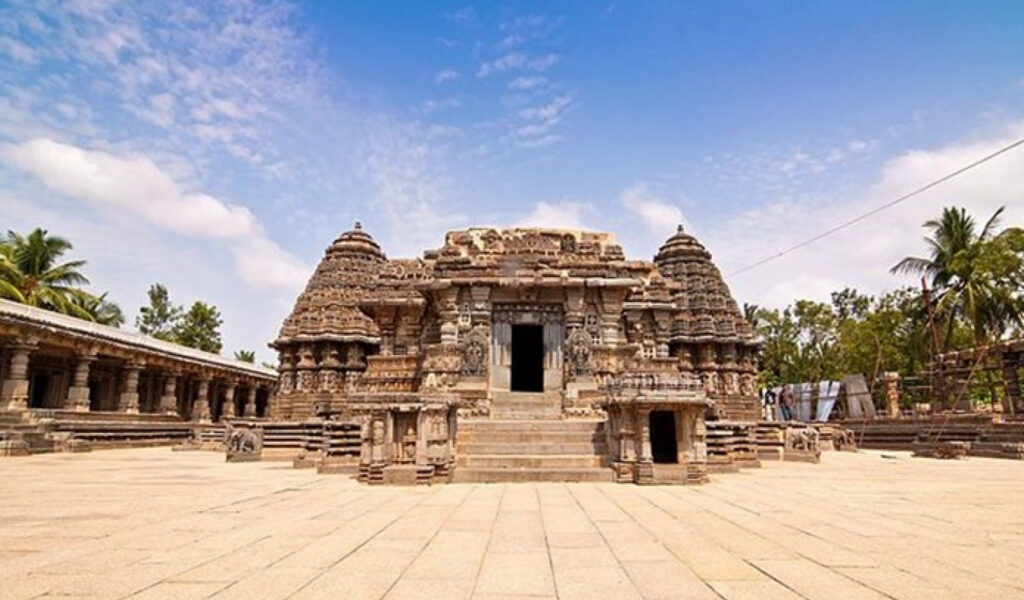
In the towns of Belur, Halebid, and Somnathpura in Karnataka, a world carved in stone can be experienced. These temples were built by the Hoysala dynasty between the 11th and 13th centuries and are praised as some of the finest architectural masterpieces of India. Divine devotion and artistic perfection were beautifully blended in their creation.
At first, they are seen as temples. But when looked at closely, they are understood as history books carved in stone—telling detailed stories of gods, kings, dancers, musicians, battles, and daily life.
Now included as a UNESCO World Heritage Site under the title “Sacred Ensembles of the Hoysalas” (added in 2023), these temples are admired for their sculptural beauty and engineering skill. They are often explored in Indian History Learning as symbols of India’s rich temple art and cultural heritage.
The Hoysala Dynasty and Their Patronage of Art
The Hoysalas ruled parts of Southern India from the 10th to the 14th centuries. While they were skilled warriors, their legacy today is most visible in their support of religion, architecture, and the arts.
- They built more than 1,500 temples across Karnataka, though only a few hundred survive today.
- Their capital cities—Belur and Halebid—became centers of temple building, cultural growth, and religious tolerance.
- The dynasty supported Shaivism, Vaishnavism, and Jainism, and their temples often reflect this spiritual inclusivity.
Under their rule, artists were given freedom and patronage to express beauty, faith, and philosophy through stone.
Stories Carved in Stone
What makes Hoysala temples truly stand out is the sheer intricacy of their carvings.
- You’ll see rows of dancing apsaras, mythological battles from the Ramayana and Mahabharata, scenes from everyday life, musicians playing instruments, animals in motion, and divine figures full of grace.
- Every inch of the temples—walls, ceilings, pillars, and doorways—is richly sculpted.
- No two sculptures are alike. Each tells a unique story, carved with precision in soft soapstone, which allowed for such fine detailing.
It’s said that some temples took decades to complete, with teams of artisans passing their skills across generations.
Unique Star-Shaped Temple Architecture
Hoysala temples are also architecturally unique. They don’t follow the typical straight or square layout found in most Indian temples.
- Many of them, like the Chennakesava Temple in Belur, are built in a star-shaped (stellate) plan, with multiple projections and recesses.
- This design allowed sunlight to fall differently throughout the day—highlighting various sculptures at different times.
- Temples are often built on a raised platform or jagati, which acts as a gallery for circumambulation and adds to the grandeur.
- The use of lathe-turned pillars, delicate ceiling motifs, and multi-tiered towers (vimanas) shows both mathematical precision and artistic creativity.
Each temple is a blend of science, spirituality, and sculpture—all crafted to last for centuries.
Temples You Can Explore
- Belur – Chennakesava Temple
Dedicated to Lord Vishnu, this temple is known for its intricately carved dancers, bracket figures, and majestic gopuram. - Halebid – Hoysaleswara Temple
Dedicated to Lord Shiva, it features some of the most elaborate stone carvings in India, including the famous dwarapalakas (door guardians) and narrative friezes. - Somnathpura – Keshava Temple
Smaller and more compact, this temple is a perfect example of symmetry, balance, and sculptural detailing on every surface.
Each temple is a testament to the Hoysala ideal—that devotion should be beautiful, artistic, and lasting.
Explore These Temples Virtually at TravelBaits
At learning.travelbaits.in, you can:
- Take virtual walkthroughs of these awe-inspiring temples
- Learn about the legends carved into the walls
- Understand the symbolism, styles, and techniques behind each structure
- Dive into visual stories and cultural quizzes that make learning fun and memorable
These temples aren’t just about the past—they’re about how art and faith shaped Indian identity. Whether you’re a student, traveler, or culture lover, the Sacred Ensembles of the Hoysalas will leave you inspired.
5. Pattadakal – Where North Meets South

Located on the banks of the Malaprabha River in northern Karnataka, Pattadakal is seen as more than just a group of ancient temples—it is known as a stone-carved blend of cultures, where North Indian Nagara and South Indian Dravidian architectural styles were beautifully combined.
Recognized as a UNESCO World Heritage Site, Pattadakal was used as the royal coronation site of the Chalukya dynasty (6th–8th century CE). It was celebrated as a spiritual and cultural center known for its diversity, innovation, and artistic excellence.
Pattadakal is now studied in Indian History Learning for its unique temple architecture and its importance in early Indian heritage.
Chalukyan Rule and Temple Architecture
The Early Chalukyas of Badami ruled over large parts of South and Central India and played a key role in developing Indian temple architecture during the 7th and 8th centuries CE.
- Pattadakal was their ceremonial capital, where kings were crowned, and monumental temples were built to mark their victories and devotion.
- The Chalukyas were patrons of Shaivism, Vaishnavism, and Jainism, and their temples reflect this religious pluralism.
- Their unique approach allowed architects to experiment with form and fusion, which gave rise to temples unlike anywhere else in India.
Pattadakal became the laboratory for a new era of architectural innovation.
Where Dravidian and Nagara Styles Meet
What makes Pattadakal extraordinary is its architectural diversity. The site has 10 major temples, and together, they tell the story of two great architectural traditions converging in harmony.
- Dravidian Style (South Indian):
Characterized by pyramidal towers (vimanas), pillared halls, and intricate stone carvings.
Examples: Sangameshwara Temple, Mallikarjuna Temple - Nagara Style (North Indian):
Known for its curvilinear shikharas (towers), and vertically aligned designs.
Example: Kashi Vishwanatha Temple - Fusion Style:
Temples like the Papanatha Temple combine features of both styles—showing how Indian art is fluid, inclusive, and evolving.
This architectural blend is rare in Indian temple complexes, making Pattadakal a key site for anyone studying or exploring Indian heritage.
Stories Carved into Stone
Each temple at Pattadakal is covered in carvings that speak volumes—not just about religion, but also about daily life, music, warfare, and mythology.
- Ramayana and Mahabharata scenes grace the pillars and walls.
- Images of gods, goddesses, musicians, dancers, and royal processions bring life to the stone.
- The Virupaksha Temple, built by Queen Lokamahadevi to commemorate her husband’s victory, is especially rich in sculptural detail—considered one of the finest Chalukyan works.
The narrative carvings are not just decorative—they’re visual storytelling tools, making temples the “picture books” of ancient India.
Explore Pattadakal Virtually at TravelBaits
With learning.travelbaits.in, you can:
- Take a virtual walk through the temple corridors of Pattadakal
- Learn about the Chalukya kings and queens and their vision for cultural unity
- Compare Nagara and Dravidian elements visually
- Discover hidden symbols and stories carved into every temple wall
Whether you’re a student, a history enthusiast, or a heritage traveler, Pattadakal offers a front-row seat to India’s architectural fusion—and now, you can experience it from anywhere in the world.
6. Ayodhya – The Birthplace of Lord Ram
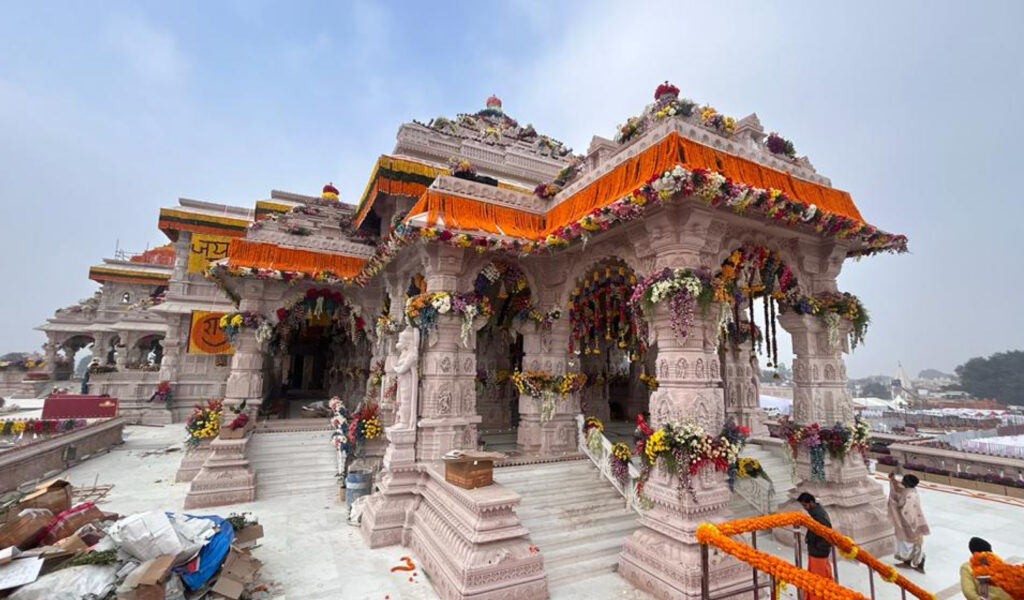
Ayodhya, one of India’s oldest and most sacred cities, is seen not just as a place but as a living legend. It is known as the birthplace of Lord Ram, the seventh incarnation of Vishnu, and is located on the peaceful banks of the Saryu River in Uttar Pradesh. The city has been remembered as the spiritual heart of the epic Ramayana, where myth, memory, and history have been blended over time.
For thousands of years, Ayodhya has been visited by sages, saints, and devotees, and has been recognized as a center of devotion, pilgrimage, and storytelling. Today, with the grand Ram Janmbhoomi Mandir being built at its center, Ayodhya is honored as a symbol of faith, dharma, and Indian identity.
It is often included in Indian History Learning as a key part of India’s religious and cultural heritage.
The Story of Lord Ram and the Legacy of the Ikshvaku Dynasty
Ayodhya was once the grand capital of the Ikshvaku dynasty, also known as the Suryavansha (Solar Lineage)—a dynasty so ancient, it is said to trace its origins to Manu, the first man in Hindu tradition.
- King Dasharatha, ruler of Ayodhya, was the father of Lord Ram.
- Ram, born in the Treta Yuga, grew up in the palaces of Ayodhya before being exiled for 14 years—an act that became the foundation of his legendary journey.
- After defeating the demon king Ravana in Lanka, Ram returned to Ayodhya and began a golden reign known as Ram Rajya—an era of justice, prosperity, and moral righteousness.
The entire city resonates with sacred geography, where real locations align with Ramayana episodes, turning Ayodhya into a spiritual map of the epic.
Sacred Spots Like Nandigram, Bharat Mandir & Kanak Bhawan
Ayodhya is filled with temples and sacred sites that mark significant moments from the life of Ram and his family:
- Ram Janmbhoomi Mandir – Built at the believed birthplace of Lord Ram, this grand temple combines ancient tradition with modern architecture, making it a symbol of cultural revival.
- Bharat Mandir (Nandigram) – Located a few kilometers away, this is where Lord Ram’s brother Bharat ruled as regent, placing Ram’s sandals on the throne during his exile—a deep symbol of brotherly love and dharma.
- Kanak Bhawan – A temple dedicated to Ram and Sita, believed to have been gifted to Sita by Queen Kaikeyi after her marriage.
- Saryu Ghat – Pilgrims bathe here in the holy river, believed to cleanse sins and bless devotees with divine grace.
Each spot in Ayodhya tells a story, not just of the divine, but also of ideals like loyalty, sacrifice, truth, and love.
How Mythology, History, and Faith Come Together in Ayodhya
What makes Ayodhya truly special is the way it exists across dimensions:
- In mythology, it is the setting of one of the most sacred texts in Hinduism, the Ramayana.
- In history, it is mentioned in ancient scriptures like the Atharva Veda, and was ruled by powerful dynasties over centuries.
- In faith, it is a Tirtha (sacred crossing)—a place where the divine touches the mortal world, and devotees feel a connection to something beyond themselves.
Even today, festivals like Ram Navami and Diwali are celebrated here with unmatched devotion, drawing pilgrims and tourists from around the globe.
Experience Ayodhya Virtually on TravelBaits
Can’t travel? You can still walk in the footsteps of Ram!
At learning.travelbaits.in, you can:
- Take guided virtual tours of temples and ghats
- Watch the story of Lord Ram through animated and documentary-style videos
- Learn about the Ikshvaku dynasty, sacred rituals, and Ramayana geography
- Play quizzes and games to test your understanding of Ayodhya’s significance
Ayodhya is more than a destination—it’s a spiritual journey into India’s cultural roots. And thanks to virtual storytelling, you don’t need to board a train to experience it.
Just log in, learn, and feel the presence of Ram from wherever you are.
7. Vrindavan – The Divine Playground of Krishna
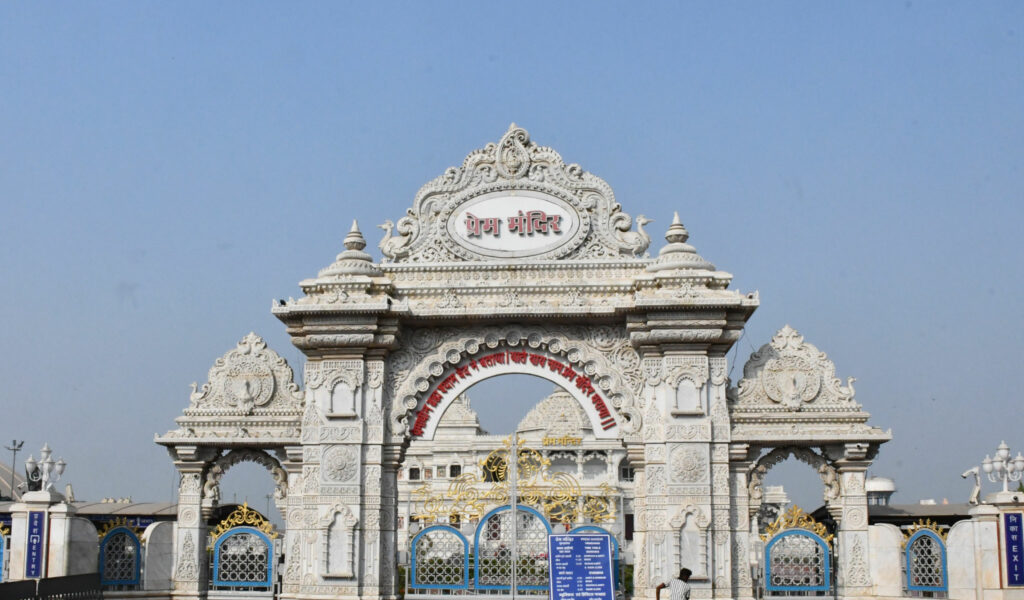
Tucked along the peaceful banks of the Yamuna River in Uttar Pradesh, Vrindavan is regarded as one of the most sacred towns in India. It is believed that Lord Krishna spent his childhood and youth here. Every street, tree, and temple is known to echo with his divine leelas (playful acts), flute music, and deep devotion.
Vrindavan is seen not just as a town but as a living expression of divine love, where myth, music, and faith have been beautifully blended. It has been celebrated as a center of Vaishnavite devotion and played a key role in the Bhakti movement. Even today, it is visited by millions of pilgrims, saints, and seekers.
Vrindavan holds an important place in Indian History Learning for its spiritual legacy and connection to Krishna’s life.
Temples That Tell Krishna’s Story
Vrindavan is home to over 5,000 temples, each preserving a unique aspect of Krishna’s divine childhood and teenage pastimes.
- Banke Bihari Temple – Perhaps the most famous in Vrindavan, this temple enshrines Krishna in his most playful and enchanting form: “Banke” (bent) and “Bihari” (enjoyer). The idol’s eyes are so captivating that darshan is given in glimpses, with curtains drawn repeatedly to avoid overwhelming devotees.
- Nidhivan – A mystical grove where it is believed that Krishna still performs the Ras Leela every night with Radha and the gopis. After sunset, no one stays inside. The trees, curiously twisted like dancing figures, are said to represent the gopis themselves.
- Sri Rangji Temple – A unique blend of South and North Indian temple architecture, dedicated to Lord Ranganatha (a reclining form of Krishna/Vishnu). It reflects Vrindavan’s openness to spiritual traditions from across India.
These sacred places are not only centers of worship but also gateways into legends, emotions, and timeless devotion.
Legends from Krishna’s Early Life
In Vrindavan, you can walk through the places where Krishna’s stories unfolded—from his mischievous childhood to his divine romances:
- Stealing butter, dancing on Kaliya the serpent, and lifting Govardhan Hill are not just myths here—they are lived experiences, reenacted through festivals, art, and bhajans.
- Krishna’s bond with Radha, his Ras Leela with the gopis, and his love for music and nature are central themes across Vrindavan’s culture.
- Even simple places like a Kunj (grove) or a Yamuna ghat are seen as sacred landscapes, where devotees feel Krishna’s presence.
This mythical geography gives Vrindavan an energy that is both mystical and profoundly intimate.
The Bhakti Movement and Vrindavan’s Role
Vrindavan played a pivotal role in the Bhakti movement, especially during the medieval period when saints emphasized devotional love (bhakti) over ritual or caste.
- Saints like Chaitanya Mahaprabhu, Vallabhacharya, Surdas, and Rupa Goswami walked these very lanes, spreading the message of divine love and surrender to Krishna.
- Vrindavan became a sanctuary for poets, mystics, and musicians, many of whom composed bhajans (devotional songs) in praise of Krishna-Radha’s eternal love.
- The philosophy of “Madhura Bhakti”—devotion expressed as the soul’s loving relationship with the divine—found its deepest roots here.
Through the Bhakti movement, Vrindavan’s influence reached across India, inspiring temples, art, music, and religious traditions for centuries to come.
Experience Vrindavan Virtually at TravelBaits
Can’t visit in person? Let the magic of Vrindavan come to you through your screen.
At learning.travelbaits.in, you can:
- Take virtual temple tours of Banke Bihari, Rangji Mandir, and Nidhivan
- Watch video stories and animations of Krishna’s divine childhood
- Learn about the Bhakti saints and their poetic legacies
- Explore devotional culture through interactive quizzes and visuals
Whether you’re a student of history, a seeker of spirituality, or simply curious, Vrindavan offers a deep emotional and cultural learning experience like no other.
Vrindavan is more than a pilgrimage—it’s an experience of love, joy, and surrender.
Through virtual learning, you can now walk its sacred paths, hear its stories, and feel the devotion that has stirred hearts for centuries.
8. Mysore – The Royal Legacy of Karnataka
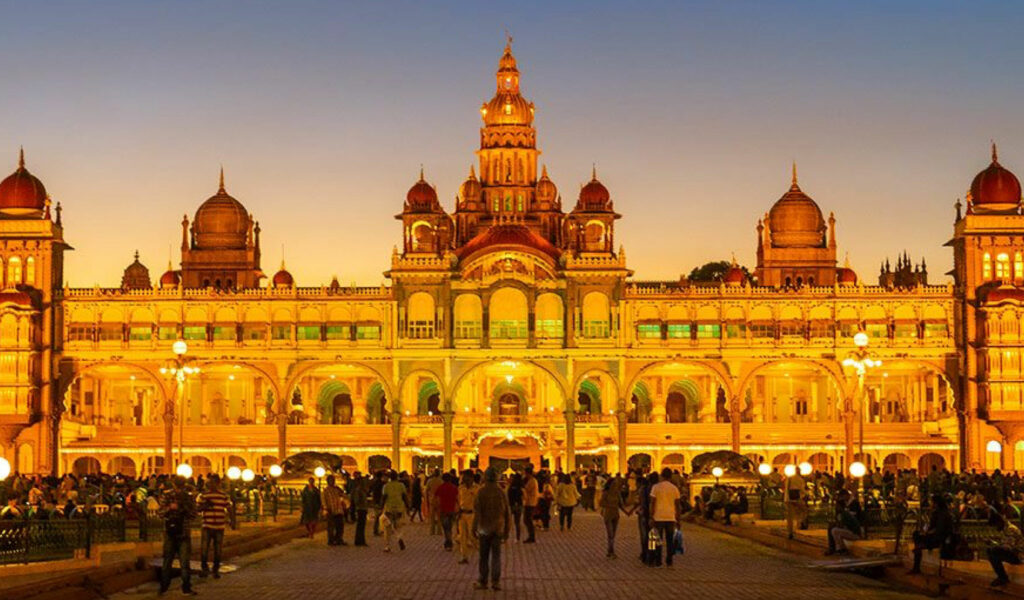
With its grand palaces, lively markets, and royal processions, Mysore is seen as a city where history can be felt in every street. It was made the capital of the Wodeyar dynasty for centuries and is remembered today as a shining example of India’s royal past, colonial history, and cultural richness.
Mysore is known not just as a royal city, but also as a center for art, architecture, yoga, and the famous Dussehra festival. A unique mix of heritage and modern learning can be experienced here.
Mysore is often explored in Indian History Learning for its royal legacy and cultural contributions.
The Wodeyar Dynasty and Royal Splendor
The Wodeyars, who ruled Mysore from 1399 to 1950 (with brief interruptions), were visionary rulers who patronized art, architecture, music, and education.
- The highlight of their legacy is the Mysore Palace, also known as the Amba Vilas Palace, an architectural masterpiece blending Hindu, Indo-Saracenic, Gothic, and Rajput styles.
- The palace is illuminated with nearly 100,000 bulbs during the Dasara festival, turning it into a golden fairy tale.
- The Wodeyars also supported artists, dancers, and scholars, making Mysore a cultural capital in South India.
Even under British suzerainty, Mysore was one of the most progressive princely states, with a focus on education, railways, and governance.
Cultural and Artistic Heritage
Mysore is a living classroom of South Indian art and tradition:
- The city is famous for Mysore painting, a classical style known for its elegance, detail, and use of gold foil.
- The Jaganmohan Palace, now an art gallery, houses some of the finest traditional and modern Indian artworks.
- Mysore is also the birthplace of Mysore Pak, Mysore silk sarees, and Carnatic music traditions.
It’s a place where royalty meets creativity.
The Grand Mysore Dasara Festival
The 10-day Mysore Dasara is one of India’s most spectacular festivals—a tradition that dates back over 400 years.
- It celebrates the victory of good over evil, with Goddess Chamundeshwari (Durga) defeating Mahishasura—the demon from whom Mysore gets its name.
- The celebrations include royal processions, cultural performances, wrestling matches, and illumination of the entire city.
- The climax is the Jumbo Savari, where caparisoned elephants carry the goddess in a golden howdah through the streets.
This festival alone offers a deep dive into Mysore’s historical, religious, and social legacy.
Explore Mysore Online with TravelBaits
At learning.travelbaits.in, you can:
- Take a virtual tour of the Mysore Palace and its stunning interiors
- Learn about the Wodeyar kings, their contributions to Karnataka, and their cultural vision
- Explore the stories behind the Dasara festival, Chamundeshwari Temple, and the origin of Mysore’s name
- Discover the city’s art, food, and architecture through engaging videos and quizzes
Whether you’re a student curious about India’s royal dynasties or a culture lover fascinated by festivals and heritage, Mysore offers an unforgettable journey through South India’s regal past.
And now, you can begin that journey—right from your screen.
How Learning.TravelBaits.in Makes It Easy and Fun
At learning.travelbaits.in, Indian history becomes a visual, interactive experience:
- Watch engaging videos with expert storytelling
- Take guided virtual tours of real locations
- Understand complex history through simple explanations
- Play quizzes and interactive challenges to make learning stick
It’s perfect for:
- Students who want to enjoy history, not just memorize it
- Teachers looking for classroom-friendly tools
- Parents who want cultural education for kids
- Travel lovers eager to explore before they visit
Begin Your History Journey Today
Instead of memorizing timelines, start exploring real places that shaped India’s story. Discover legends, dynasties, and sacred sites that bring history alive.
👉 Visit learning.travelbaits.in and take your first step into the past—the smarter, more fun way to learn Indian history online.

